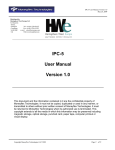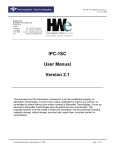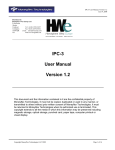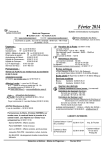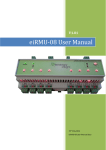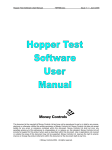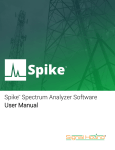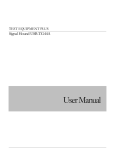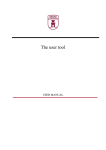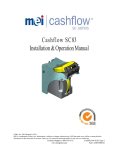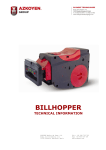Download IPC-1 User Manual Version 1.3
Transcript
IPC-1 User Manual, Version 1.3 Dec 19, 2008 Distributed by Hemisphere West Europe Ltd Ty Bryneirin Sarnau, Llandysul Tel: +44 (0) 1239 654157 Ceredigion Fax:+44 (0) 1239 654742 SA44 6QR e-mail: [email protected] UK Web:www.hwiglobal.com IPC-1 User Manual Version 1.3 This document and the information contained in it are the confidential property of Moneyflex Technologies. It must not be copied, duplicated or used in any manner, or transmitted to others without prior written consent of Moneyflex Technologies. It must be returned to Moneyflex Technologies when its authorized use is terminated. This copyright extends to all the media in which this information may be preserved including magnetic storage, optical storage, punched card, paper tape, computer printout or visual display. Copyright Moneyflex Technologies LLC 2008 Page 1 of 16 IPC-1 User Manual, Version 1.3 Dec 19, 2008 Document change history Version 1.0 1.1 Date Nov-15-07 1.2 1.3 Jun-19-08 Dec-19-08 Comments First release Mar-18-08 Adds description to Introduction. Controller 09 adds relay function. Adds port output in Section 4.8. Changes wording “all Controllers” to “some Controllers” in Global Suspend command. CE declaration of conformity and ESD precaution statement added. No Hot Plug warning added. Disclaimer Universal Serial Bus (USB) is a trademark of USB Implementer Forum, Inc. Microsoft Windows 98, Windows Me, Windows 2000, Windows XP, Windows Vista are trademarks of Microsoft Corporation. Multi-Drop Bus (MDB) and Internal Communication Protocol (ICP) are communication standards set by National Automatic Merchandising Association. Extended Bi-Directional Serial (EBDS) Protocol is a serial communication standard set by MEI. ccTalk is a serial communication standard set by Money Controls. Hardware and electrical connections given in this manual are for illustration purposes only. Moneyflex Technologies LLC bears no responsibility of any damage or hazard that may cause. Scope of this manual This manual is to provide an overall view of the IPC products and IPC-1, in particular its architecture and operations. There are two more Moneyflex documents user will need before he / she can do the PC programming: PG001-0 Programmer’s Guide K1 Protocol Specification Other suggested reading material: FTDI driver documents at http://www.ftdichip.com/FTDocuments.htm NAMA MDB / ICP v3.0 Specification Product manual of the respective peripherals Copyright Moneyflex Technologies LLC 2008 Page 2 of 16 IPC-1 User Manual, Version 1.3 Dec 19, 2008 1.0 INTRODUCTION The Intelligent Protocol Communicator (IPC) series is a set of products designed to solve many of the connection and interface problems found in nowadays automated payment systems. No matter your money validating device utilizes an output format of a Simple Pulse, Dry relay contacts, a Parallel or Binary output, a MEI™ EBDS serial port, an ITL SSP® port, a NAMA® MDB / ICP daisy-chained bus system or the ccTalk bidirectional serial data line, IPC validates them all. IPC consolidates all the status and events happening in your peripherals and reports them in a systematic way back to your application. It utilizes the efficient K-1 Protocol for communication between your application and IPC device. This unifies different communication standards found in different peripherals into one easy to learn language. IPC makes PC based vending machine, timed internet café and POS system work like a champ. With IPC working in your system, you can take all the guess works out of your cash and cashless payment system. 1.1 IPC-1 FEATURES • • • • • • • • • • USB 2.0 full speed connectivity Industrial standard controller chipset supports OSes such as: Windows 98, Me, 2K, XP, Vista, Linux, Mac OS 8, 9, X and more SDKs and Drivers for software developers Easy to use Moneyflex developed K1 Protocol A patent pending PC Supervisory System that monitors your PC and OS so that they will not go out of control A programmable General Purpose Relay Contact for external device switching Dual currency device input ports for bill / coin acceptor and MDB peripherals A full version of NAMA® MDB / ICP host port for advance users [open mode] An auto MDB host control for automatic operations [controller mode] A versatile Pulse / Parallel / Binary input port to connect to a bill or coin acceptor 1.2 TERMINOLOGY Below listed the terminologies and their explanation that are widely used in this manual. MFX PC OS, OSes Device MCU, MCUs Controller =Short for Moneyflex Technologies LLC. =Personal computer. An IBM x86 compatible machine. =PC operation system, systems. =IPC itself or a general USB Device. =Micro-Processor(s) inside the device. Some devices may have multiple MCUs running together in parallel for parallel processing. A single MCU may house multiple Controllers within. = An individual working unit that serves a particular function. Copyright Moneyflex Technologies LLC 2008 Page 3 of 16 IPC-1 User Manual, Version 1.3 Dec 19, 2008 Controller ID Peripheral User K1 Protocol NAMA® MDB / ICP MDB Host MDB Power Bill Acceptor Coin Charger ms USB-IF 2.0 = An unique Address ID in Hex format that the Controller is defined to. = A functional unit attaches to IPC and is controlled by an IPC Controller. = User’s PC application program. For better readability, this manual adopts a male user gender and uses “he” instead of “it” to represent the program. = MFX developed computer protocol adopted by IPC and other products. = The National Automatic Merchandising Association = Multi-Drop Bus / Internal Communication Protocol communication standard developed by NAMA for use in vending and food service management industry. = The MDB bus master where all the MDB commands initiate. Almost known as Vending Machine Controller (VMC). = The voltage and current requirements of a MDB peripheral. = A device that validates paper currency (banknote) and give corresponding credits. It may have the capability to secure the banknote after validation. = A device validates coins and give corresponding credits. It may have the capability to store the coin after validation and/or dispense a particular kind of coins upon request. In IPC application, this can be a simple coin comparator or a coin acceptor/mechanism. = millisecond(s). 1/1000th of a second. = Universal Serial Bus Implementer Forum. www.usb.org ARCHITECTURE An IPC consists of one or more CPUs working together, called the MCUs to achieve parallel processing power. Each MCU has a number of different Controllers built into it. The Controller is the working unit that user is dealing with. When user is talking to IPC, he is actually talking to an individual Controller by using the K1 Protocol. The protocol enables user to specify which Controller the message is directed to. Only the intended Controller with a correct ID number will reply to the request. On top of that, there is a set of global commands that all Controllers will response to. Each Controller has its own firmware known as the kernel. The kernel version can be retrieved by user at anytime in his application. By checking the kernel version, user can know the updated information about that particular Controller. The USB controller used in IPC is a USB 2.0 full speed chipset conforms to USB 2.0 standard set by USB-IF. Its main function is to inter-connect all MCUs reside within the device and distribute user commands to/from each Controllers. 2.1 KERNEL UPGRADE Controllers’ kernel is flash ROM based. Occasionally MFX will release a new kernel version for a particular controller for newer features. This kind of upgrade can only be conducted at MFX appointed service site. Any attempt to tamper with the kernel program will lead to unit malfunction and void all warranties. Copyright Moneyflex Technologies LLC 2008 Page 4 of 16 IPC-1 User Manual, Version 1.3 Dec 19, 2008 2.2 PC INSTALLATION The procedure of a PC OS (eg. Windows) registers a USB device and gets it ready for use is called Enumeration. When a USB device plugs in to a USB port, OS receives the Vendor ID (VID) and Product ID (PID) from the device. By sorting out these two IDs, OS loads the correct driver files (*.inf) / system files (*.sys) / dynamic link library files (*.dll) / etc… The device is then assigned with a HandleID. Application program can uses this HandleID to access the device. Warning: Always use MFX provided device drivers for correct operation. Failure to do so will result in installation failure and/or OS crashing. Visit website www.moneyflex.net for latest driver options. Upon successful enumeration, IPC is recognized as a Universal Serial Bus Controller. 2.3 CODE DEVELOPMENT For complete programming details, please refer to PG001-0 Programmer Guide. Here are some examples of K1 Protocol. • DEVICE RESET, Global command This command resets all Controllers, including PC Supervisor within the Device. All setup parameters will need to re-install after this command. • ADDRESS CLASH, Global command This command requests all Controllers within the Device to show their existence by replying with their respective Controller ID. In order to avoid multiple Controllers sending their ID at the same time, IPC adopts a timing scheme for this. The elapse time of each Controller to send its ID is based on its ID value multiplied by 5ms time. For instance, a Controller with Controller ID 10 hex (16 dec) will reply a ‘10H’ at 16 x 5ms, that is 80ms. Copyright Moneyflex Technologies LLC 2008 Page 5 of 16 IPC-1 User Manual, Version 1.3 Dec 19, 2008 3.0 • GLOBAL SUSPEND, Global command This command puts most Controllers within the Device to stop their operations and enter into suspend mode. Depending on the nature of the Controller, some Controllers will turn off the attached peripheral or some will finish the current event before entering into suspend mode. Refer to the respective Controller for details. • USER SUSPEND, Controller command This command puts the respective Controller into suspend condition. Depending on the nature of the Controller, some Controllers will turn off the attached peripheral or will finish with the current operation before entering into suspend mode. Refer to the respective Controller for details. CONTROLLERS OVERVIEW IPC-1 has the following Controllers built in: [Controller ID] 09 (hex) 10 (hex) 12 (hex) [Functions] PC Supervisor / General Purpose Relay Contact Bill / coin acceptor input with Pulse / Parallel / Binary input options NAMA™ MDB / ICP Host 3.1 Controller 09 (hex), PC Supervisor / General Purpose Relay Switch 3.1.1 Configured as a PC Supervisor PC technology has evolved to an era that its unprecedented computing power and multi tasking ability are useful in many critical and non-critical applications. Countless remote systems have been deployed in unsupervised areas to run 24/7 unattended for a prolong period of time. It is not hard to realize that system stability is the key concern. ATM terminals, pay-to-surf internet booths, electronic payment kiosks are just a few examples of PC based systems. If these systems have more than desired down time due to OS instability or the application is not to perfection, the purposes of the system are compromised. The PC Supervisor Controller is a patent pending design (at print time) to safeguard of this irrational moment to free your PC from going wild. Once the Controller detects a system hung up situation it will send in a hard reset to your PC to reset it to its original state. This practically reduces down time to minimum and saves up a lot of service expenses. The work principle of the PC Supervisor is similar to a watchdog timer to govern the PC ping time. Once setup, the PC must continue to ping the Controller within the programmed time interval. Otherwise it is considered as a PC failure. The Controller will then send a reset signal to the PC down to the hardware (on motherboard) level. During the reset period, the Controller will keep monitoring the amount of time required for the PC / OS to reboot and resume normal operations. If the reboot time is longer than expected, it is considered as a reboot failure. Another reset sequence will follow. Copyright Moneyflex Technologies LLC 2008 Page 6 of 16 IPC-1 User Manual, Version 1.3 Dec 19, 2008 PC Supervisor has the following parameters to setup: [WatchDog Timer] The maximum time interval between ping without causing a PC reset. 5 minutes may be a reasonable value to start with. Some PC applications will hold up CPU for several minutes before releasing it to other applications. Do not put too stringent timing at here to avoid false PC reset. [Reboot Timer] The maximum time interval between PC reset to PC restart, OS loading and finally to application resume running. This timer stops once the normal ping resumes. If this timer expires, a PC reset will happen. This is to safeguard of repeated reboot failure. 20 minutes may be a suitable value to start with. [Reset Hold Time] The hold time of the RESET signal . The built-in relay actuates a hard reset to the PC motherboard. 2 seconds is a nominal time of such a reset action. Once the Controller is setup, it runs forever until a “Disable” setup or a “Global Reset” command is received. No other operation will stop the timer. This Controller does not stop on Global Suspend and no User Suspend is available. 3.1.2 Configured as a General Purpose Relay contact This function is available in Kernel version VIPM1.1.1 or later Warning: Do not use Relay function when Controller is configured as a PC Supervisor This controller provides a pair of a dry relay contact capable to switch small signal voltage up to 24VDC 2A. This is particular useful in application to control an external device having a separate (isolated) power source. 3.2 Controller 10 (hex), Bill / coin acceptor input with Pulse / Parallel / Binary input options This Controller is designed to work with most bill / coin acceptors that employ different I/O methods. No matter the acceptor is outputting credit in a simple pulse or a parallel or binary format, this Controller captures all events happening and report them in an easy to use Event Reporting packet. On each event request (poll) sent by user, Controller replies with 6 most recent events happened in the acceptor together with an Event Counter. By working out the number of events exists between polls, user can obtain a Copyright Moneyflex Technologies LLC 2008 Page 7 of 16 IPC-1 User Manual, Version 1.3 Dec 19, 2008 complete list of action of the acceptor. Thus a missing event is a history to this kind of time critical application. In a slow polling system, if the acceptor has accepted two or more credits and waiting to be reported, the Controller will put the acceptor into suspend mode to stop further operation of the acceptor. Upon subsequent poll, the acceptor operation will be resumed. [Simple Pulse Input] Acceptor gives a pulse stream on an output line. The number of pulses is proportional to the number of credit(s). Use any one of the 6 input lines is possible. [Standard Parallel Input] Acceptor uses up to 6 individual output lines to represent 6 distinctive credit values. Each pulse on an output line represents that particular credit value has been accepted. Up to 6 different credit values can be addressed. Simultaneous inputs are possible. [Binary Input] Acceptor uses 4 combined output lines to send out credit information in a Binary format. Up to 15 different credit channels (values) can be addressed. In additions to the above options, this Controller also provides the following settings for user to choose: [Pulse width setting] This allows user to setup pulse width acceptance window to fight against fraudulent or electrical noise from surroundings. This is particular useful in noisy environment or ESD slapping. Refer to your acceptor manual for the correct pulse width. [Lockup time] After a valid pulse is received on an input line, a 10ms of lockout time is imposed on that line to avoid accepting noise due to electrical bounces or slow skew rate of acceptor output line. [Enable / Lockout / Inhibit logic setting] This function let user turn on and turn off the acceptor at anytime. Different acceptor manufacturers may have different logic polarity for this. This Controller provides an option of {ACTIVE HIGH Enable | LOW Disable} or {ACTIVE LOW Enable | HIGH Disable}. Refer to your acceptor manual for correct logic setting. [Failure / Alarm signal] Acceptor may have a failure or alarm signal output to notify the system malfunction or an alarm situation has entered. This Controller provides an option of {ACTIVE HIGH activation} or {ACTIVE LOW activation}. Refer to your acceptor manual for correct logic setting. [Suspend] Besides the User and Global suspends there are two situations where the Controller will disable the acceptor. o The Controller will disable the acceptor when there are 2 or more credits pending to be reported. This happens if the poll rate is slower than the performance of the acceptor. Copyright Moneyflex Technologies LLC 2008 Page 8 of 16 IPC-1 User Manual, Version 1.3 Dec 19, 2008 o 3.3 Once the stored events are reported, the Controller will resume the acceptor for normal operation. To ease this problem, user should increase the poll frequency. When the Controller does not receive a poll for more than 5 seconds. This is to prevent the acceptor from accepting future credits when the application software is not working properly. Once the poll resumes, the Controller will enable the acceptor again. Controller 12 (hex), NAMA™ MDB / ICP HOST MDB or ICP is a communication standard widely adopted by vending machine manufacturers for connection among bill acceptor, coin changer, card reader, etc to the host system (VMC). MDB communication employs a 11-bit serial byte format. The Mode bit being the 9th bit (MSB) of the byte dictates the direction of the message. This unique arrangement gives PC based serial ports a great challenge to handle properly. Plus the 1ms response time requirement almost throws away all non-RTOS systems. In view of this, MFX developed this Controller to relief the above difficulties. This Controller gives user an alternative way to work with MDB system. User can access to virtually all available MDB machines in the market. There are two modes to select from the Controller: [Controller Mode] In Controller Mode, the following two standard peripherals are supported. Either one peripheral or both can be connected together to this host in a daisy chain manner. Bill Acceptor; MDB Address 30H, Level 1 or higher Coin Changer; MDB Address 08H, Level 2 or higher This mode is ideal for user who wants to focus on his application rather than encoding and decoding the MDB communications. Minimal MDB knowledge and interaction is required. Once setup, the Controller initiates communication to the peripherals and start accessing their functions Operation sequence: [Controller Mode Setup] [Searching…] [Status (Setup)] [Send Enable Command]* [Poll] … repeat polling on every ~ 400ms * After reset, Enable command data is all zero. User needs to send Enable data. Once the peripherals come online, the Controller automatically polls for their latest status. On each event request (Poll) sent by user, Controller replies with 8 most recent events / status Copyright Moneyflex Technologies LLC 2008 Page 9 of 16 IPC-1 User Manual, Version 1.3 Dec 19, 2008 happened in the peripherals together with the Event Counter. By working out the events received, user can get a complete list of actions happened in the peripherals. [Open Mode] In Open Mode, user has a full access to all MDB capabilities. User can program for his peripherals and do the polling system at his discretion. User can also daisy chain additional peripherals onto the MDB bus in compliance to MDB specification. Refer to NAMA® MDB / ICP specification for programming details. 4.0 HARDWARE An outlook of IPC-1 device box. Warning: NEVER HOT PLUG the device into power supply. Otherwise excessive current surge may damage both IPC and peripherals. 4.1 LED Patterns IPC provides 4 status LEDs for user to diagnose with his system. They are the: [POWER] [USB COMMS] [IPC ACTIVITIES] Turns on when IPC connects to power Blinks when USB activities TX and RX are undergoing Quick flashes when IPC receives a credit or alarm signal from peripheral Momentarily on when Reset Supervisory system is resetting PC Flashes @ 1Hz when Reboot Timer is ticking Copyright Moneyflex Technologies LLC 2008 Page 10 of 16 IPC-1 User Manual, Version 1.3 Dec 19, 2008 [MDB COMMS] 4.2 Flashes when MDB activities TX and RX are undergoing Electrical Hookups IPC-1 has a POWER PORT, USB PORT, ACCEPTOR PORT, MDB HOST PORT and PC RESET PORT. 4.3 POWER PORT 12-34VDC This port is a center positive power plug with a 2.1mm center pin. Connect REGULATED DC power to this port for IPC and some attached peripheral(s). Warning: NEVER HOT PLUG the device into power supply. Otherwise excessive current surge may damage both IPC and peripherals. Copyright Moneyflex Technologies LLC 2008 Page 11 of 16 IPC-1 User Manual, Version 1.3 Dec 19, 2008 [Single input setup, single voltage] Either the ACCEPTOR PORT or MDB PORT is used. Not BOTH. • ACCEPTOR PORT, 12VDC only Most bill / coin acceptors operate at 12VDC. Refer to their respective user manual for guarantee. Provide only with the correct voltage. • MDB PORT, MDB Power only MDB peripherals usually work between 18VDC to 34VDC. Refer to their respective user manual for correct voltage setup. When more than one MDB peripherals are connected together in a daisy chain manner, the total power requirement equals the sum of the maximum power (Amp) drawn by all active peripherals at their peak power. Be sure to provide with enough current (Amp). [Dual input setup, dual voltage] When both the ACCEPTOR PORT and MDB PORT are used. Supply POWER PORT with the voltage required by the device connected to the ACCEPTOR PORT. Use MFX cable P/N: WB02EA0 (MDB extension cable with detachable power lines) for MDB PORT to connect to MDB peripherals. Unplug the power connector of the cable. Supply MDB Power to the power connector on the peripheral side. Warning: Do not use MDB Power on the POWER PORT in a Dual input setup. This will cause severe damage to all peripherals and IPC itself. 4.4 USB PORT This is a USB 2.0, type B full speed port. Connects this port to a PC root hub or a USB hub. Use only USB 2.0 capable cable. For less noise connection, always connects to PC root hub found on the back of PC (direct to motherboard). 4.5 ACCEPTOR PORT 3M P/N: 30310-5002HB; Mated with 3M P/N: 89110-0103 IDC socket or AMP P/N: 102387-1 [Simple Pulse Input connection table] PIN # FUNCTION TYPE CONNECTS TO ACCEPTOR PIN 1 PIN 2 PWR GND, 0V PWR POS, +12V Power Power Power Negative Power Positive Copyright Moneyflex Technologies LLC 2008 Page 12 of 16 IPC-1 User Manual, Version 1.3 Dec 19, 2008 PIN 3 PIN 4 PIN 5 PIN 6 PIN 7 PIN 8 PIN 9 PIN 10 Credit Line 5 Credit Line 6 Alarm Line Enable Line Credit Line 1 Credit Line 2 Credit Line 3 Credit Line 4 Input Input Input Output Input Input Input Input Failure / Alarm Enable / Lockout / Inhibit Pulse Stream Output* Pulse Stream Output* -- connects to any 1 of the 6 Credit lines of this connector. [Standard Parallel Input connection table] PIN # FUNCTION TYPE CONNECTS TO ACCEPTOR PIN 1 PIN 2 PIN 3 PIN 4 PIN 5 PIN 6 PIN 7 PIN 8 PIN 9 PIN 10 PWR GND, 0V PWR POS, +12V Credit Line 5 Credit Line 6 Alarm Line Enable Line Credit Line 1 Credit Line 2 Credit Line 3 Credit Line 4 Power Power Input Input Input Output Input Input Input Input Power Negative Power Positive Output Line 5 Output Line 6 Failure / Alarm Enable / Lockout / Inhibit Output Line 1 Output Line 2 Output Line 3 Output Line 4 [Binary Input connection table] PIN # FUNCTION TYPE CONNECTS TO ACCEPTOR PIN 1 PIN 2 PIN 3 PIN 4 PIN 5 PIN 6 PIN 7 PIN 8 PIN 9 PIN 10 PWR GND, 0V PWR POS, +12V Credit Line 5 Credit Line 6 Alarm Line Enable Line Credit Line 1 Credit Line 2 Credit Line 3 Credit Line 4 Power Power Input Input Input Output Input Input Input Input Power Negative Power Positive n/a n/a Failure / Alarm Enable / Lockout / Inhibit Output Line 1 Output Line 2 Output Line 3 Output Line 4 [Binary Input to Credit Channel table] Copyright Moneyflex Technologies LLC 2008 Page 13 of 16 IPC-1 User Manual, Version 1.3 Dec 19, 2008 Credit Line 4 Credit Line 3 Credit Line 2 Credit Line 1 -------On On On On On On On On ---On On On On ----On On On On -On On --On On --On On --On On On -On -On -On -On -On -On -On Channel 1 Channel 2 Channel 3 Channel 4 Channel 5 Channel 6 Channel 7 Channel 8 Channel 9 Channel 10 Channel 11 Channel 12 Channel 13 Channel 14 Channel 15 4.6 MDB PORT Molex P/N: 39-30-1060; Mated with Molex P/N: 39-01-2060 or AMP P/N: 106527-6 MDB Host Port Note: Refers to POWER PORT section for MDB Power connection The MDB bus (wire) consists of power lines and signal lines. Power is supplied from Host to peripherals. Voltage ranges from 18VDC to 34VDC. In some unregulated host system, it may reach as high as 42V. Signal lines consist of Transmit (TXD), Receive (RXD) and Signal GND. Connector Pin-out: Line 1 - 34 VDC Line 2 - DC Power Return Line 3 - N/C Line 4 - Master Receive Line 5 - Master Transmit Line 6 - Communications Common 6 5 4 3 2 1 Looking toward connector 4.7 PC RESET PORT Copyright Moneyflex Technologies LLC 2008 Page 14 of 16 IPC-1 User Manual, Version 1.3 Dec 19, 2008 Molex P/N: 70553-0001; Mated with Molex P/N: 50-57-9402 1. Use Moneyflex cable P/N: WA01BA0 (PC Reset Cable) to connect this port and to user’s PC motherboard RESET pins 2. and to RESET button leads of the computer case. Below diagrams are for illustration only. Different PC motherboard manufacturers may have different location for RESET pin headers. Refer to your motherboard manual for details. RESET pins 4.8 GENERAL PURPOSE RELAY CONTACTS Molex P/N: 70553-0001; Mated with Molex P/N: 50-57-9402 This port shares with the PC RESET PORT. Connects this port to the device of switching. Copyright Moneyflex Technologies LLC 2008 Page 15 of 16 IPC-1 User Manual, Version 1.3 Dec 19, 2008 5.0 CE Declaration of Conformity We certify that this product complies with the requirements of the EC Council Directive on electromagnetic compatibility 2004/108/EC Applicable Standards with amendments: EN55022: 2006 EN55024: 1998 +A1: 2001 +A2: 2003 EN61000-3-2: 2006 EN61000-3-3: 1995 +A1: 2001 +A2: 2005 Electrostatic Discharge Precaution: The normal function of the device may be disrupted by a strong electromagnetic interference. If so, simply reset the device by cycling the power. Normal operation should be resumed. If in such a case that the function could not be resumed, relocate the device to another ESD-safe location. Copyright Moneyflex Technologies LLC 2008 Page 16 of 16
















